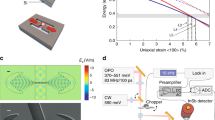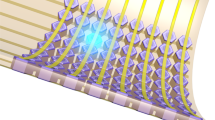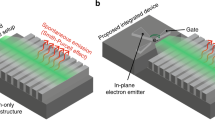Abstract
Germanium is an attractive material for silicon-compatible optoelectronics, but in its bulk form it does not emit light efficiently because of its indirect bandgap. Applying tensile strain to germanium modifies its band structure such that radiative recombination is enhanced, leading to improved light emission. Here, we introduce the ‘suspension platform for optoelectronics under tension’, a micromachining-based technology that applies large, locally tunable tensile strains to suspended device layers. Using this approach, we demonstrate dramatically enhanced light emission from uniaxially and biaxially tensile-strained germanium-on-insulator device layers. Photoluminescence enhanced by a factor of 130 at a wavelength of 1,550 nm and integrated enhancement by greater than a factor of 260 over bulk germanium are described. The emission exhibits a superlinear dependence on optical pump power. We also report preliminary evidence for enhanced electroluminescence from suspended germanium-on-insulator light-emitting diodes.
This is a preview of subscription content, access via your institution
Access options
Subscribe to this journal
Receive 12 print issues and online access
$209.00 per year
only $17.42 per issue
Buy this article
- Purchase on Springer Link
- Instant access to full article PDF
Prices may be subject to local taxes which are calculated during checkout






Similar content being viewed by others
References
Soref, R. The past, present, and future of silicon photonics. IEEE J. Sel. Top. Quant. Electron. 12, 1678–1687 (2006).
Kasper, E. Prospects and challenges of silicon/germanium on-chip optoelectronics. Frontiers Optoelectron. China 3, 143–152 (2010).
Reed, G. T., Mashanovich, G., Gardes, F. Y. & Thomson, D. J. Silicon optical modulators. Nature Photon. 4, 518–526 (2010).
Michel, J., Liu, J. & Kimerling, L. C. High-performance Ge-on-Si photodetectors. Nature Photon. 4, 527–534 (2010).
Leuthold, J., Koos, C. & Freude, W. Nonlinear silicon photonics. Nature Photon. 4, 535–544 (2010).
Dosunmu, O. I. et al. Resonant cavity enhanced Ge photodetectors for 1550 nm operation on reflecting Si substrates. IEEE J. Sel. Top. Quant. Electron. 10, 694–701 (2004).
Chen, L. & Lipson, M. Ultra-low capacitance and high speed germanium photodetectors on silicon. Opt. Express 17, 7901–7906 (2009).
Assefa, S., Xia, F. & Vlasov, Y. A. Reinventing germanium avalanche photodetector for nanophotonic on-chip optical interconnects. Nature 464, 80–84 (2010).
Fischetti, M. V. & Laux, S. E. Band structure, deformation potentials, and carrier mobility in strained Si, Ge, and SiGe alloys. J. Appl. Phys. 80, 2234–2252 (1996).
Cao, L., Park, J.-S., Fan, P., Clemens, B. & Brongersma, M. L. Resonant germanium nanoantenna photodetectors. Nano Lett. 10, 1229–1233 (2010).
Stoney, G. G. The tension of metallic films deposited by electrolysis. Proc. Math. Phys. Eng. Sci. 82, 172–175 (1909).
Thompson, S. E. et al. A logic nanotechnology featuring strained-silicon. IEEE Electron. Dev. Lett. 25, 191–193 (2004).
Ghani, T. et al. A 90 nm high volume manufacturing logic technology featuring novel 45 nm gate length strained silicon CMOS transistors. IEDM Tech. Dig. 978–980 (2003).
Mistry, K. et al. Delaying forever: uniaxial strained silicon transistors in a 90 nm CMOS technology. Symp. VLSI Tech. Dig. 50–51 (2004).
Philipp, H. R. & Taft, E. A. Optical constants of germanium in the region 1 to 10 eV. Phys. Rev. 113, 1002–1005 (1959).
Jain, J. R. et al. Tensile-strained germanium-on-insulator substrate fabrication for silicon-compatible optoelectronics. Opt. Mater. Express 1, 1121–1126 (2011).
Sun, X., Liu, J., Kimerling, L. C. & Michel, J. Room-temperature direct bandgap electroluminesence from Ge-on-Si light-emitting diodes. Opt. Lett. 34, 1198–1200 (2009).
Klingenstein, W. & Schweizer, H. Direct gap recombination in germanium at high excitation level and low temperature. Solid State Electron. 21, 1371–1374 (1978).
Cheng, T.-H. et al. Competitiveness between direct and indirect radiative transitions of Ge. Appl. Phys. Lett. 96, 091105 (2010).
Liu, J. et al. Tensile-strained, n-type Ge as a gain medium for monolithic laser integration on Si. Opt. Express 15, 11272–11277 (2007).
van Roosbroeck, W. & Shockley, W. Photon-radiative recombination of electrons and holes in germanium. Phys. Rev. 94, 1558–1560 (1954).
Brill, P. H. & Schwarz, R. F. Radiative recombination in germanium. Phys. Rev. 112, 330–333 (1958).
Marchetti, S., Martinelli, M., Simili, R., Giorgi, M. & Fantoni, R. Measurement of Ge electrical parameters by analysing its optical dynamics. Phys. Scr. 64, 509–511 (2001).
van de Walle, C. G. Band lineups and deformation potentials in the model-solid theory. Phys. Rev. B 39, 1871–1883 (1989).
Zhang, F., Crespi, V. H. & Zhang, P. Prediction that uniaxial tension along <111> produces a direct band gap in germanium. Phys. Rev. Lett. 102, 156401 (2009).
Acknowledgements
This work was carried out at the Stanford Nanofabrication Facility of the National Nanotechnology Infrastructure Network. The authors thank D.S. Ly-Gagnon and K.C. Balram of Stanford University for useful discussions. Funding for A.H. and M.L.B. was obtained from the Si-based Laser Initiative of the Multidisciplinary University Research Initiative (MURI) under the Air Force Aerospace Research OSR (award no. FA9550-06-1-0470).
Author information
Authors and Affiliations
Contributions
J.R.J. and R.T.H. conceived the idea for the technology. J.R.J. conducted strain simulations, device fabrication, photoluminescence and Raman measurements/analysis, theoretical modelling/analysis and manuscript preparation. A.H. contributed to photoluminescence measurements/analysis and manuscript preparation. T.M.B. contributed to photoluminescence and Raman analysis and manuscript preparation. D.A.B.M contributed to photoluminescence and Raman analysis, theoretical modelling/analysis and manuscript preparation. M.L.B contributed to photoluminescence and Raman analysis, theoretical modelling/analysis and manuscript preparation. R.T.H. also contributed to photoluminescence and Raman analysis, theoretical analysis and manuscript preparation.
Corresponding author
Ethics declarations
Competing interests
The authors declare no competing financial interests.
Supplementary information
Supplementary information
Supplementary information (PDF 1065 kb)
Rights and permissions
About this article
Cite this article
Jain, J., Hryciw, A., Baer, T. et al. A micromachining-based technology for enhancing germanium light emission via tensile strain. Nature Photon 6, 398–405 (2012). https://doi.org/10.1038/nphoton.2012.111
Received:
Accepted:
Published:
Issue Date:
DOI: https://doi.org/10.1038/nphoton.2012.111
This article is cited by
-
Direct bandgap emission from strain-doped germanium
Nature Communications (2024)
-
Prospects and applications of on-chip lasers
eLight (2023)
-
The amazing world of self-organized Ge quantum dots for Si photonics on SiN platforms
Applied Physics A (2023)
-
Strain engineering of anisotropic light–matter interactions in one-dimensional P-P chain of SiP2
Nano Research (2022)
-
SiN-based platform toward monolithic integration in photonics and electronics
Journal of Materials Science: Materials in Electronics (2021)



